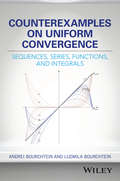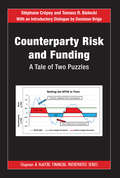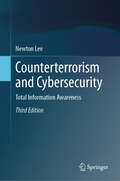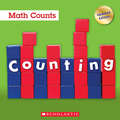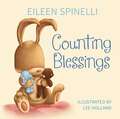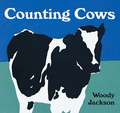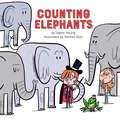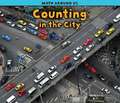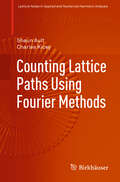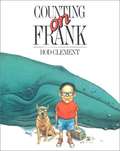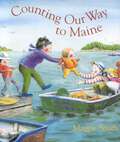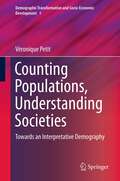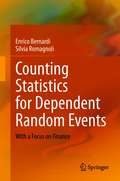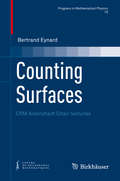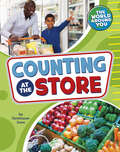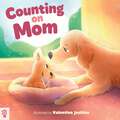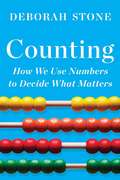- Table View
- List View
Counterexamples on Uniform Convergence: Sequences, Series, Functions, and Integrals
by Andrei Bourchtein Ludmila BourchteinA comprehensive and thorough analysis of concepts and results on uniform convergence Counterexamples on Uniform Convergence: Sequences, Series, Functions, and Integrals presents counterexamples to false statements typically found within the study of mathematical analysis and calculus, all of which are related to uniform convergence. The book includes the convergence of sequences, series and families of functions, and proper and improper integrals depending on a parameter. The exposition is restricted to the main definitions and theorems in order to explore different versions (wrong and correct) of the fundamental concepts and results. The goal of the book is threefold. First, the authors provide a brief survey and discussion of principal results of the theory of uniform convergence in real analysis. Second, the book aims to help readers master the presented concepts and theorems, which are traditionally challenging and are sources of misunderstanding and confusion. Finally, this book illustrates how important mathematical tools such as counterexamples can be used in different situations. The features of the book include: • An overview of important concepts and theorems on uniform convergence • Well-organized coverage of the majority of the topics on uniform convergence studied in analysis courses • An original approach to the analysis of important results on uniform convergence based\ on counterexamples • Additional exercises at varying levels of complexity for each topic covered in the book • A supplementary Instructor’s Solutions Manual containing complete solutions to all exercises, which is available via a companion website Counterexamples on Uniform Convergence: Sequences, Series, Functions, and Integrals is an appropriate reference and/or supplementary reading for upper-undergraduate and graduate-level courses in mathematical analysis and advanced calculus for students majoring in mathematics, engineering, and other sciences. The book is also a valuable resource for instructors teaching mathematical analysis and calculus. ANDREI BOURCHTEIN, PhD, is Professor in the Department of Mathematics at Pelotas State University in Brazil. The author of more than 100 referred articles and five books, his research interests include numerical analysis, computational fluid dynamics, numerical weather prediction, and real analysis. Dr. Andrei Bourchtein received his PhD in Mathematics and Physics from the Hydrometeorological Center of Russia. LUDMILA BOURCHTEIN, PhD, is Senior Research Scientist at the Institute of Physics and Mathematics at Pelotas State University in Brazil. The author of more than 80 referred articles and three books, her research interests include real and complex analysis, conformal mappings, and numerical analysis. Dr. Ludmila Bourchtein received her PhD in Mathematics from Saint Petersburg State University in Russia.
Countering Air Terrorism (Springer Aerospace Technology)
by Pavel Pavlovich HachikyanThis book examines the issues of ensuring anti-terrorist security of an aviation enterprise, provides a history of terrorism in the aviation sector, and analyzes the legal regulations. This book provides mathematical and mathematical–psychological models for reducing the risk of terrorist threats, which makes it possible to objectively increase the safety of air transport facilities, reduce the likelihood of terrorist attacks, save human lives and prevent significant material losses. The solutions of general humanistic problems proposed in the book—preventing accidents and preserving the world—are an original feature of the book, which allows one to treat it with the necessary attention and interest for the reader. The concept of anti-terrorist security of an aviation enterprise presented in this book has been widely tested and introduced into the activities of leading aviation enterprises, including the Interstate Aviation Committee (IAC), and has been used in the investigation of aviation accidents. This book is written for a wide range of audience associated with ensuring aviation transport security and for the end users of airlines—passengers, in order to expand their knowledge about the reliability of using air transport.
Counterparty Risk and Funding: A Tale of Two Puzzles (Chapman and Hall/CRC Financial Mathematics Series #31)
by Damiano Brigo Stéphane Crépey Tomasz R. BieleckiSolve the DVA/FVA Overlap Issue and Effectively Manage Portfolio Credit Risk Counterparty Risk and Funding: A Tale of Two Puzzles explains how to study risk embedded in financial transactions between the bank and its counterparty. The authors provide an analytical basis for the quantitative methodology of dynamic valuation, mitigation, and hedging of bilateral counterparty risk on over-the-counter (OTC) derivative contracts under funding constraints. They explore credit, debt, funding, liquidity, and rating valuation adjustment (CVA, DVA, FVA, LVA, and RVA) as well as replacement cost (RC), wrong-way risk, multiple funding curves, and collateral. The first part of the book assesses today’s financial landscape, including the current multi-curve reality of financial markets. In mathematical but model-free terms, the second part describes all the basic elements of the pricing and hedging framework. Taking a more practical slant, the third part introduces a reduced-form modeling approach in which the risk of default of the two parties only shows up through their default intensities. The fourth part addresses counterparty risk on credit derivatives through dynamic copula models. In the fifth part, the authors present a credit migrations model that allows you to account for rating-dependent credit support annex (CSA) clauses. They also touch on nonlinear FVA computations in credit portfolio models. The final part covers classical tools from stochastic analysis and gives a brief introduction to the theory of Markov copulas. The credit crisis and ongoing European sovereign debt crisis have shown the importance of the proper assessment and management of counterparty risk. This book focuses on the interaction and possible overlap between DVA and FVA terms. It also explores the particularly challenging issue of counterparty risk in portfolio credit modeling. Primarily for researchers and graduate students in financial mathematics, the book is also suitable for financial quants, managers in banks, CVA desks, and members of supervisory bodies.
Counterterrorism and Cybersecurity: Total Information Awareness
by Newton LeeCounterterrorism and cybersecurity are the top two priorities at the Federal Bureau of Investigation (FBI). Graduated from the FBI Citizens Academy in 2021, Prof. Newton Lee offers a broad survey of counterterrorism and cybersecurity history, strategies, and technologies in the 3rd edition of his riveting book that examines the role of the intelligence community, cures for terrorism, war and peace, cyber warfare, and quantum computing security. From September 11 attacks and Sony-pocalypse to Israel’s 9/11 and MOAB (Mother of All Breaches), the author shares insights from Hollywood such as 24, Homeland, The Americans, and The X-Files. In real life, the unsung heroes at the FBI have thwarted a myriad of terrorist attacks and cybercrimes. The FBI has worked diligently to improve its public image and build trust through community outreach and pop culture. Imagine Sherlock Holmes meets James Bond in crime fighting, FBI Director Christopher Wray says, “We’ve got technically trained personnel—with cutting-edge tools and skills you might never have imagined seeing outside of a James Bond movie—covering roughly 400 offices around the country.” This book is indispensable for anyone who is contemplating a career at the FBI, think tanks, or law enforcement agencies worldwide. It is also a must-read for every executive to safeguard their organization against cyberattacks that have caused more than $10 billion in damages. In the spirit of President John F. Kennedy, one may proclaim: “Ask not what counterterrorism and cybersecurity can do for you, ask what you can do for counterterrorism and cybersecurity.” Praise for the First Edition: “The book presents a crisp narrative on cyberattacks and how to protect against these attacks. … The author views terrorism as a disease that may be cured through education and communication. … The book is a relevant, useful, and genial mix of history, current times, practical advice, and policy goals.” - Brad Reid, ACM Computing Reviews “Very professional and well researched.” - Eleanor Clift, Newsweek and The Daily Beast
Counting (Math Counts: Updated Editions)
by Henry PluckroseAn introduction to capacity for the youngest readers!Math Counts series introduces young readers (grades K-3) to early math concepts. Real-world examples and corresponding photos make math concepts easy to grasp.Counting helps us find out "how many?"
Counting Blessings
by Eileen SpinelliFrom award-winning author Eileen Spinelli, this cozy and adorable book is perfect for bedtime, teaching your kids to count to ten, or even presenting the idea of thankfulness as an everyday event. And the rhyming text and child-friendly illustrations make this book wonderful for toddlers and young readers.Counting Blessings follows a young bunny as he counts his blessings through his day, as well as explores all the blessings awaiting him throughout the rest of the year. As you child counts along from 1 to 10, they will learn to be thankful for the simple, everyday things—like family, warm clothes, and favorite toys—as well as the things that make the day extra-special, like ten good night kisses. With rhymes that make counting fun to remember and illustrations with elements your child can find and count along with, this delightful board book captures the attention of young children, filling their minds with numbers and their hearts with happiness.Counting Blessings:makes counting fun and relatable for kidshelps your child look for and count the blessings in their own lifealso contains elements about the four seasonsis perfect for lap reading
Counting Cows
by Woody JacksonCows munch, meander, sleep, sun themselves, and wade through vibrant Vermont landscapes before gathering for a kick-up-your-hooves barn dance. This bold, bovine twist on counting is sure to amuse little ones just learning their numbers.
Counting Elephants
by Dawn YoungMath + Magic = chaos. A zany book about counting elephants before they disappear! Our poor counter just wants to count her ten elephants, but - POOF! - her magician friend is making it impossible. Ten, nine, eight... each time we get back to counting, one of the elephants has been changed into something unexpected. Puppies, frogs, peanut butter and jelly, and, of course, a rabbit and a hat appear and disappear in this funny, fast-paced story.
Counting In The City (Math Around Us)
by Tracey StefforaThis title uses simple text and vivid images to give readers concrete examples through which they can further develop number sense from zero to ten.
Counting Lattice Paths Using Fourier Methods (Applied and Numerical Harmonic Analysis)
by Shaun Ault Charles KiceyThis monograph introduces a novel and effective approach to counting lattice paths by using the discrete Fourier transform (DFT) as a type of periodic generating function. Utilizing a previously unexplored connection between combinatorics and Fourier analysis, this method will allow readers to move to higher-dimensional lattice path problems with ease. The technique is carefully developed in the first three chapters using the algebraic properties of the DFT, moving from one-dimensional problems to higher dimensions. In the following chapter, the discussion turns to geometric properties of the DFT in order to study the corridor state space. Each chapter poses open-ended questions and exercises to prompt further practice and future research. Two appendices are also provided, which cover complex variables and non-rectangular lattices, thus ensuring the text will be self-contained and serve as a valued reference.Counting Lattice Paths Using Fourier Methods is ideal for upper-undergraduates and graduate students studying combinatorics or other areas of mathematics, as well as computer science or physics. Instructors will also find this a valuable resource for use in their seminars. Readers should have a firm understanding of calculus, including integration, sequences, and series, as well as a familiarity with proofs and elementary linear algebra.
Counting Our Way to Maine
by Maggie SmithFirst published in 1995 by Orchard Books, this book takes one baby, two dogs, and three bicycles on a journey from the big city to Maine's seacoast. Objects packed for the trip and things seen along the way are all happily counted, finishing in a shining finale as the family tallies 20 fireflies found during their last evening in Maine.
Counting Populations, Understanding Societies: Towards a Interpretative Demography (Demographic Transformation and Socio-Economic Development #1)
by Véronique PetitThe core aim of this book is to determine how anthropology and demography can be used in conjunction in the field of population and development. The boundaries of demography are not as clearly defined or as stable as one might think, especially in view of the tension between a formal demography centered on the 'core of procedures and references' and a more open form of demography, generally referred to as Population Studies. Many rapprochements, missed opportunities and isolated attempts marked the disciplinary history of anthropology and demography, both disciplines being founded on distinct and highly differentiated traditions and practices. Moreover, the role and the place assigned to epistemology differ significantly in ethnology and demography. Yet, anthropology and demography provide complementary models and research instruments and this book shows that neither discipline can afford to overlook their respective contributions. Based on research conducted in West Africa over more than twenty years, it is a defense of field demography that makes case for a continuum ranging from the initial conception of fieldwork and research to its effective implementation and to data analysis. Changes in behaviors relating to fertility, poverty or migration cannot be interpreted without invoking the cultural factor at some stage. Representations in their collective and individual dimensions also fit into the extended explanatory space of demography.
Counting Pumpkins
by Ellen SenisiJoin two friends counting pumpkins— and find a surprise at the end!
Counting Statistics for Dependent Random Events: With a Focus on Finance
by Silvia Romagnoli Enrico BernardiThis book on counting statistics presents a novel copula-based approach to counting dependent random events. It combines clustering, combinatorics-based algorithms and dependence structure in order to tackle and simplify complex problems, without disregarding the hierarchy of or interconnections between the relevant variables. These problems typically arise in real-world applications and computations involving big data in finance, insurance and banking, where experts are confronted with counting variables in monitoring random events.In this new approach, combinatorial distributions of random events are the core element. In order to deal with the high-dimensional features of the problem, the combinatorial techniques are used together with a clustering approach, where groups of variables sharing common characteristics and similarities are identified and the dependence structure within groups is taken into account. The original problems can then be modeled using new classes of copulas, referred to here as clusterized copulas, which are essentially based on preliminary groupings of variables depending on suitable characteristics and hierarchical aspects.The book includes examples and real-world data applications, with a special focus on financial applications, where the new algorithms’ performance is compared to alternative approaches and further analyzed. Given its scope, the book will be of interest to master students, PhD students and researchers whose work involves or can benefit from the innovative methodologies put forward here. It will also stimulate the empirical use of new approaches among professionals and practitioners in finance, insurance and banking.
Counting Surfaces: CRM Aisenstadt Chair lectures (Progress in Mathematical Physics #70)
by Bertrand EynardThe problem of enumerating maps (a map is a set of polygonal "countries" on a world of a certain topology, not necessarily the plane or the sphere) is an important problem in mathematics and physics, and it has many applications ranging from statistical physics, geometry, particle physics, telecommunications, biology, . . . etc. This problem has been studied by many communities of researchers, mostly combinatorists, probabilists, and physicists. Since 1978, physicists have invented a method called "matrix models" to address that problem, and many results have been obtained. Besides, another important problem in mathematics and physics (in particular string theory), is to count Riemann surfaces. Riemann surfaces of a given topology are parametrized by a finite number of real parameters (called moduli), and the moduli space is a finite dimensional compact manifold or orbifold of complicated topology. The number of Riemann surfaces is the volume of that moduli space. More generally, an important problem in algebraic geometry is to characterize the moduli spaces, by computing not only their volumes, but also other characteristic numbers called intersection numbers. Witten's conjecture (which was first proved by Kontsevich), was the assertion that Riemann surfaces can be obtained as limits of polygonal surfaces (maps), made of a very large number of very small polygons. In other words, the number of maps in a certain limit, should give the intersection numbers of moduli spaces. In this book, we show how that limit takes place. The goal of this book is to explain the "matrix model" method, to show the main results obtained with it, and to compare it with methods used in combinatorics (bijective proofs, Tutte's equations), or algebraic geometry (Mirzakhani's recursions). The book intends to be self-contained and accessible to graduate students, and provides comprehensive proofs, several examples, and gives the general formula for the enumeration of maps on surfaces of any topology. In the end, the link with more general topics such as algebraic geometry, string theory, is discussed, and in particular a proof of the Witten-Kontsevich conjecture is provided. <
Counting and Measuring: An Approach to Number Education in the Infant School
by Eileen M. ChurchillThe teaching of numbers in the primary grades is seen in this book as the foundation of the beginnings of mathematical understanding. Mathematics is taken to be a language, and the aim of its teaching is to make the pupil, so to speak, bilingual, or so to increase his understanding that he is able to translate a concrete numerical problem into the symbolic language of calculation. For a child taught along these lines, how much easier, for example, would be the transition from arithmetic to algebra!<P><P>Miss Churchill is fully conversant with the works of Piaget, Cuisenaire, Cassirer and other leading thinkers in educational philosophy, psychology, and linguistics. She has synthesized their concepts with her own experience and research at Leeds University, and, though written within the contexts of British education, her book should also have a marked influence on the teaching of young children in North America.
Counting at the Store (The World Around You)
by Christianne JonesPiles of tart apples. Cans of delicious soup. Rows of crunchy carrots. The grocery store is full of tasty foods and other items to count. The interactive, rhyming text and colorful photographs will have young learners counting along with every page in this picture book.
Counting on Community
by Innosanto NagaraCounting on Community is Innosanto Nagara's follow-up to his hit ABC book, A is for Activist. Counting up from one stuffed piñata to ten hefty hens--and always counting on each other--children are encouraged to recognize the value of their community, the joys inherent in healthy eco-friendly activities, and the agency they posses to make change. A broad and inspiring vision of diversity is told through stories in words and pictures. And of course, there is a duck to find on every page!
Counting on Mom
by Odd DotA beautifully illustrated picture book that encourages readers to count and celebrate all the moms around them!1 mom waking, 2 moms eating, 3 moms walking . . .Moms are all around us! This simple counting book encourages readers to count and celebrate all the amazing moms around them--the heroes kids count on everyday! Moms playing; moms relaxing; moms helping each other and their kids. It's a joyful opportunity to celebrate all that moms are and do! With sweet animal characters and charming art, this is the perfect gift book for new moms and at Mother's Day and all year long.
Counting on Snow
by Maxwell NewhouseMaxwell Newhouse, folk artist extraordinaire, has created a unique counting book. The premise is simple. He invites children to count with him from ten crunching caribou down to one lonely moose, by finding other northern animals - from seals to wolves to snowy owls - as they turn the pages. But as the animals appear, so does the snow, until it's a character too, obliterating light and dark, sky and earth. A gorgeous exploration of the isolation and the beauty of northern winter, Maxwell Newhouse has created a deceptively simple picture book that can be enjoyed by all ages.
Counting with Symmetric Functions (Developments in Mathematics #43)
by Anthony Mendes Jeffrey RemmelThis monograph provides a self-contained introduction to symmetric functions and their use in enumerative combinatorics. It is the first book to explore many of the methods and results that the authors present. Numerous exercises are included throughout, along with full solutions, to illustrate concepts and also highlight many interesting mathematical ideas. The text begins by introducing fundamental combinatorial objects such as permutations and integer partitions, as well as generating functions. Symmetric functions are considered in the next chapter, with a unique emphasis on the combinatorics of the transition matrices between bases of symmetric functions. Chapter 3 uses this introductory material to describe how to find an assortment of generating functions for permutation statistics, and then these techniques are extended to find generating functions for a variety of objects in Chapter 4. The next two chapters present the Robinson-Schensted-Knuth algorithm and a method for proving Pólya's enumeration theorem using symmetric functions. Chapters 7 and 8 are more specialized than the preceding ones, covering consecutive pattern matches in permutations, words, cycles, and alternating permutations and introducing the reciprocity method as a way to define ring homomorphisms with desirable properties. Counting with Symmetric Functions will appeal to graduate students and researchers in mathematics or related subjects who are interested in counting methods, generating functions, or symmetric functions. The unique approach taken and results and exercises explored by the authors make it an important contribution to the mathematical literature.
Counting-Out Rhymes: A Dictionary
by Roger D. Abrahams Lois RankinEeny, meeny, figgledy, fig. Delia, dolia, dominig,Ozy, pozy doma-nozy,Tee, tau, tut,Uggeldy, buggedy, boo!Out goes you. (no. 129)You can stand,And you can sit,But, if you play,You must be it. (no. 577)Counting-out rhymes are used by children between the ages of six and eleven as a special way of choosing it and beginning play. They may be short and simple ("O-U-T spells out/And out goes you") or relatively long and complicated; they may be composed of ordinary words, arrant nonsense, or a mixture of the two. Roger D. Abrahams and Lois Rankin have gathered together a definitive compendium of counting-out rhymes in English reported to 1980. These they discovered in over two hundred sources from the nineteenth and twentieth centuries, including rhymes from England, Scotland, Ireland, Australia, New Zealand, and the United States. Representative texts are given for 582 separate rhymes, with a comprehensive listing of sources and variants for each one, as well as information on each rhyme's provenience, date, and use. Cross-references are provided for variants whose first lines differ from those of the representative texts. Abrahams's introduction discusses the significance of counting-out rhymes in children's play. Children's folklore and speech play have attracted increasing attention in recent years. Counting-Out Rhymes will be a valuable resource for researchers in this field.
Counting: How We Use Numbers To Decide What Matters
by Deborah Stone“Deborah Stone’s mind-altering insight is that the numbers we use to capture the human experience are themselves a form of creative story-telling. They shouldn’t end the conversation, but spark a deeper and richer one. Counting deserves five stars for showing why five stars can never tell the whole story.” —Jacob S. Hacker, co-author of Let Them Eat Tweets: How the Right Rules in an Age of Extreme Inequality What do people do when they count? What do numbers really mean? We all know that people can lie with statistics, but in this groundbreaking work, eminent political scientist Deborah Stone uncovers a much deeper problem. With help from Dr. Seuss and Cookie Monster, she explains why numbers can’t be objective: in order to count, one must first decide what counts. Every number is the ending to a story built on cultural assumptions, social conventions, and personal judgments. And yet, in this age of big data and metric mania, numbers shape almost every facet of our lives: whether we get hired, fired, or promoted; whether we get into college or out of prison; how our opinions are gathered and portrayed to politicians; or how government designs health and safety regulations. In warm and playful prose, Counting explores what happens when we measure nebulous notions like merit, race, poverty, pain, or productivity. When so much rides on numbers, they can become instruments of social welfare, justice, and democracy—or not. The citizens of Flint, Michigan, for instance, used numbers to prove how their household water got contaminated and to force their government to take remedial action. In stark contrast, the Founding Fathers finessed an intractable conflict by counting each slave as three-fifths of a person in the national census. They set a terrible precedent for today’s politicians who claim to solve moral and political dilemmas with arithmetic. Suffused with moral reflection and ending with a powerful epilogue on COVID-19’s dizzying statistics, Counting will forever change our relationship with numbers.
